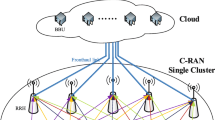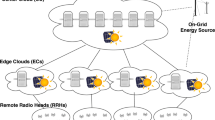Abstract
The Cloud Radio Access Network (C-RAN) with centralized processing features achieves efficient and unified resource management to meet the quality of service (QoS) requirements, while results in an increment of energy consumption. To reach a tradeoff between energy efficiency and QoS, jointly considering baseband unit (BBU) computing resource, remote radio head (RRH) power, and fronthaul (FH) link capacity optimization for delay-aware traffic is an NP-hard problem. In this paper, we propose a system energy efficiency optimization model jointing multiple resources allocation for C-RAN downlink transmission. The end-to-end delay (De) in the proposed model is formulated by the established user data queue model, which satisfies the strict Lyapunov stability. Then, based on defining an improved Drift-Plus-Penalty function \(F_{DPP}\) to transform the proposed original problem into two sub-problems which are BBU service rate allocation and RRH power control problems. The optimal BBU service rate and RRH transmission power of a single slot are obtained through solving a linear equation and applying a convolution neural network (CNN), respectively. Further, we propose an iterative-based optimization algorithm to achieve the optimal resource allocation for each slot. The simulation results show that the proposed optimization algorithm effectively reaches the balance between energy efficiency and QoS, and achieves better energy efficiency compared with the decomposition allocation method based on heuristic algorithm and BBU scheduling based on first-fit-decreasing (FFD) algorithm with lower computational complexity.









Similar content being viewed by others
References
Checko, A., Christiansen, H. L., Yan, Y., Scolari, L., Kardaras, G., Berger, M. S., & Dittmann, L. (2014). Cloud ran for mobile networks-a technology overview. IEEE Communications surveys & tutorials, 17(1), 405–426.
Xia, W., Quek, T. Q., Zhang, J., Jin, S., & Zhu, H. (2019). Programmable hierarchical c-ran: From task scheduling to resource allocation. IEEE Transactions on Wireless Communications, 18(3), 2003–2016.
Lee, Y., Miyanabe, K., Nishiyama, H., Kato, N., & Yamada, T. (2019). Threshold-based rrh switching scheme considering baseband unit aggregation for power saving in a cloud radio access network. IEEE Systems Journal, 13(3), 2676–2687.
Fang, C.-H., Shen, L.-H., Huang, T.-P., & Feng, K.-T. (2022). Delay-aware admission control and beam allocation for 5g functional split enhanced millimeter wave wireless fronthaul networks. IEEE Transactions on Wireless Communications, 21(4), 2430–2444. https://doi.org/10.1109/TWC.2021.3112299
Younis, A., Tran, T. X., & Pompili, D. (2018). Bandwidth and energy-aware resource allocation for cloud radio access networks. IEEE Transactions on Wireless Communications, 17(10), 6487–6500. https://doi.org/10.1109/TWC.2018.2860008
Zamani, A., Taghizadeh, O., & Schmeink, A. (2021). Energy-efficient joint association and precoding in ultra-dense c-ran. IEEE Transactions on Vehicular Technology, 70(3), 2862–2866.
Fettweis, G., & Zimmermann, E. (2008). ICT energy consumption-trends and challenges. In Proceedings of the 11th international symposium on wireless personal multimedia communications (Vol. 2, No. 4, p. 6). Finland: Lapland.
Kempf, J., & Yegani, P. (2002). Openran: A new architecture for mobile wireless internet radio access networks. IEEE Communications Magazine, 40(5), 118–123.
Niknam, S., Roy, A., Dhillon, H.S., Singh, S., Banerji, R., Reed, J.H., Saxena, N., Yoon, S. (2020). Intelligent o-ran for beyond 5g and 6g wireless networks. arXiv preprint arXiv:2005.08374
Singh, S.K., Singh, R., Kumbhani, B. (2020). The evolution of radio access network towards open-ran: Challenges and opportunities. In 2020 IEEE Wireless Communications and Networking Conference Workshops (WCNCW), pp. 1–6. IEEE
Sun, Y., Li, C., Huang, Y., Yang, L. (2016). Energy-efficient resource allocation in c-ran with fronthaul rate constraints. In 2016 8th International Conference on Wireless Communications & Signal Processing (WCSP), pp. 1–6. IEEE
Pan, C., Zhu, H., Gomes, N. J., & Wang, J. (2017). Joint precoding and rrh selection for user-centric green mimo c-ran. IEEE Transactions on wireless Communications, 16(5), 2891–2906.
Dai, B., & Yu, W. (2016). Energy efficiency of downlink transmission strategies for cloud radio access networks. IEEE Journal on Selected Areas in Communications, 34(4), 1037–1050.
Tang, J., Tay, W. P., & Quek, T. Q. (2015). Cross-layer resource allocation with elastic service scaling in cloud radio access network. IEEE Transactions on Wireless Communications, 14(9), 5068–5081.
Yu, N., Miao, Y., Mu, L., Du, H., Huang, H., & Jia, X. (2016). Minimizing energy cost by dynamic switching on/off base stations in cellular networks. IEEE Transactions on Wireless Communications, 15(11), 7457–7469.
Li, R., Zhao, Z., Chen, X., Palicot, J., & Zhang, H. (2014). Tact: A transfer actor-critic learning framework for energy saving in cellular radio access networks. IEEE Transactions on Wireless Communications, 13(4), 2000–2011.
Yang, Y., Chen, L., Dong, W., & Wang, W. (2014). Active base station set optimization for minimal energy consumption in green cellular networks. IEEE Transactions on Vehicular Technology, 64(11), 5340–5349.
Cheng, Y., Pesavento, M., & Philipp, A. (2013). Joint network optimization and downlink beamforming for comp transmissions using mixed integer conic programming. IEEE Transactions on Signal Processing, 61(16), 3972–3987.
Yan, J., Li, J., Zhao, L., & Chen, R. (2014). Robust joint transmit beamforming with qos guarantees in time-asynchronous das. IEEE Transactions on Vehicular Technology, 64(4), 1506–1518.
Ha, V. N., Le, L. B., et al. (2015). Coordinated multipoint transmission design for cloud-rans with limited fronthaul capacity constraints. IEEE Transactions on Vehicular Technology, 65(9), 7432–7447.
Tao, M., Chen, E., Zhou, H., & Yu, W. (2016). Content-centric sparse multicast beamforming for cache-enabled cloud ran. IEEE Transactions on Wireless Communications, 15(9), 6118–6131.
Luo, S., Zhang, R., & Lim, T. J. (2014). Downlink and uplink energy minimization through user association and beamforming in c-ran. IEEE Transactions on Wireless Communications, 14(1), 494–508.
Park, S.-H., Jeong, S., Na, J., Simeone, O., Shitz, S.S. (2021). Collaborative cloud and edge mobile computing in c-ran systems with minimal end-to-end latency. IEEE Transactions on Signal and Information Processing over Networks
Shen, L.-H., Tsai, C.-L., Wang, C.-Y., & Feng, K.-T. (2022). Hybrid controlled user association and resource management for energy-efficient green rans with limited fronthaul. IEEE Access, 10, 5264–5280. https://doi.org/10.1109/ACCESS.2022.3140814
Al-Zubaedi, W., Al-Raweshidy, H.S. (2017). A parameterized and optimized bbu pool virtualization power model for c-ran architecture. In IEEE EUROCON 2017-17th International Conference on Smart Technologies, pp. 38–43. IEEE
Noor, S., Nordin, R., & Ismail, M. (2020). An improved-water filling algorithm power allocation in network mimo. Telecommunication Systems, 8(9), 113–119.
Yu, N., Song, Z., Du, H., Huang, H., Jia, X. (2017). Multi-resource allocation in cloud radio access networks. In 2017 IEEE International Conference on Communications (ICC), pp. 1–6. IEEE
Zhang, J., Chen, S., Guo, X., Shi, J., & Hanzo, L. (2019). Boosting fronthaul capacity: Global optimization of power sharing for centralized radio access network. IEEE Transactions on Vehicular Technology, 68(2), 1916–1929.
Cai, Y., Yu, F. R., & Bu, S. (2014). Cloud computing meets mobile wireless communications in next generation cellular networks. IEEE Network, 28(6), 54–59.
Liao, Y., Song, L., Li, Y., & Zhang, Y. A. (2016). How much computing capability is enough to run a cloud radio access network? IEEE Communications Letters, 21(1), 104–107.
Akkarajitsakul, K., Hossain, E., Niyato, D., & Kim, D. I. (2011). Game theoretic approaches for multiple access in wireless networks: A survey. IEEE Communications Surveys & Tutorials, 13(3), 372–395.
Wang, S., Sun, Y. (2017). Enhancing performance of heterogeneous cloud radio access networks with efficient user association. In 2017 IEEE International Conference on Communications (ICC), pp. 1–6. IEEE
Han, T., & Ansari, N. (2017). Network utility aware traffic load balancing in backhaul-constrained cache-enabled small cell networks with hybrid power supplies. IEEE Transactions on Mobile Computing, 16(10), 2819–2832.
Sahu, B. J., Dash, S., Saxena, N., & Roy, A. (2017). Energy-efficient bbu allocation for green c-ran. IEEE Communications Letters, 21(7), 1637–1640.
Younis, A., Tran, T. X., & Pompili, D. (2021). Energy-efficient resource allocation in c-rans with capacity-limited fronthaul. IEEE Transactions on Mobile Computing, 20(2), 473–487. https://doi.org/10.1109/TMC.2019.2942597
Luong, P., Gagnon, F., Despins, C., & Tran, L.-N. (2017). Optimal joint remote radio head selection and beamforming design for limited fronthaul c-ran. IEEE Transactions on Signal Processing, 65(21), 5605–5620.
Neely, M. J. (2010). Stochastic network optimization with application to communication and queueing systems. Synthesis Lectures on Communication Networks, 3(1), 1–211.
Auer, G., Giannini, V., Desset, C., Godor, I., Skillermark, P., Olsson, M., Imran, M. A., Sabella, D., Gonzalez, M. J., Blume, O., & Fehske, A. (2011). How much energy is needed to run a wireless network? IEEE Wireless Communications, 18(5), 40–49. https://doi.org/10.1109/MWC.2011.6056691
Dinkelbach, W. (1967). On nonlinear fractional programming. Management science, 13(7), 492–498.
Shi, Q., Razaviyayn, M., Luo, Z.-Q., & He, C. (2011). An iteratively weighted mmse approach to distributed sum-utility maximization for a mimo interfering broadcast channel. IEEE Transactions on Signal Processing, 59(9), 4331–4340.
Khan, S., Muhammad, K., Mumtaz, S., Baik, S. W., & de Albuquerque, V. H. C. (2019). Energy-efficient deep cnn for smoke detection in foggy iot environment. IEEE Internet of Things Journal, 6(6), 9237–9245. https://doi.org/10.1109/JIOT.2019.2896120
Xie, J., Fang, J., Liu, C., & Li, X. (2020). Deep learning-based spectrum sensing in cognitive radio: A cnn-lstm approach. IEEE Communications Letters, 24(10), 2196–2200. https://doi.org/10.1109/LCOMM.2020.3002073
Mai, Z., Chen, Y., & Du, L. (2021). A novel blind mmwave channel estimation algorithm based on ml-elm. IEEE Communications Letters, 25(5), 1549–1553. https://doi.org/10.1109/LCOMM.2021.3049885
Acknowledgements
This work was supported by 2020 Industrial Technology Foundation Public Service Platform Project (No.2020-0105-2-1)
Author information
Authors and Affiliations
Author notes
Yueyun Chen, Yating Xie and Guang Chen have contributed equally to this work.
Corresponding author
Ethics declarations
Conflict of interest
Some journals require declarations to be submitted in a standardised format. Please check the Instructions for Authors of the journal to which you are submitting to see if you need to complete this section. If yes, your manuscript must contain the following sections under the heading ‘Declarations’:
Additional information
Publisher's Note
Springer Nature remains neutral with regard to jurisdictional claims in published maps and institutional affiliations.
Appendix A Proof of the Throrem 2
Appendix A Proof of the Throrem 2
For the update equation of user queue, the two sides of the equation are squared. By applying the inequality
we can obtain
where \(B_{lya}\left( t \right) = \frac{1}{2}\sum \limits _{n = 1}^N {\left( {\mu _n^2\left( t \right) + R_n^2\left( t \right) } \right) }\).
Because of the capacity limitation of the fronthaul link \({\mu _n}\left( t \right) \le {R_{n\max }}\) and the maximum data transmission rate of the downlink \({R_n}(t) \le R_{\max }^n\), \(B_{lya}\) satisfies the inequality,
where \(B_{lya} = \frac{1}{2}\sum \limits _{n = 1}^N {\left[ {{{\left( {{R_{n\max }}} \right) }^2} + {{\left( {R_{\max }^n} \right) }^2}} \right] }\). By inserting (A2) and (A3) into the \({F_{DPP}}\) (24), Theorem 2 can be proved.
Rights and permissions
Springer Nature or its licensor holds exclusive rights to this article under a publishing agreement with the author(s) or other rightsholder(s); author self-archiving of the accepted manuscript version of this article is solely governed by the terms of such publishing agreement and applicable law.
About this article
Cite this article
Mai, Z., Chen, Y., Xie, Y. et al. An energy efficiency optimization jointing resource allocation for delay-aware traffic in fronthaul constrained C-RAN. Wireless Netw 29, 353–368 (2023). https://doi.org/10.1007/s11276-022-03118-2
Accepted:
Published:
Issue Date:
DOI: https://doi.org/10.1007/s11276-022-03118-2




